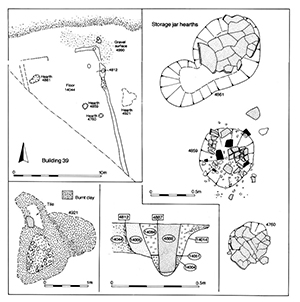
Probably toward the end of Period 3 (mid-2nd century), Building 39 is constructed on the road frontage (Figure 93). The building and closely associated features, as defined by lying west of newly introduced subdividing boundary Structure 27, are described here. Contemporary activity to the east of this boundary is described in the next section.

Building 39 comprises the foundations of a large rectangular structure (Figure 94), immediately south of the junction of Roads 2 and 3. It appears that the site of the building is deliberately levelled, with underlying features being infilled and consolidated with rubbish-rich deposit 4993 (Group 750), and likely preparation layers 4855, 4899 and 4992 (Group 749) laid down. The building post-dates pit 14006 (Group 753), of apparent mid-2nd century AD infill date.
Substantial parts of the north and east sides are exposed within Excavation Area K, the remainder extending beyond the edge of the site. The positions of the external walls are marked by foundation slots 4810 and 4812/4814/4816 (Group 723), which are 0.4m wide but survive only to a depth of 0.05m. The slots contain a compact orange clay fill. Closely spaced post-holes (4929, 14078 Group 904) are discerned within the base of excavated slot segment 4812, with the clay fill packed around them. Other post-holes are also in evidence in the unexcavated parts of the foundation slots (i.e. 4889, 14014). As recorded, the remains define a building at least 14m by 7m in area. The 3m-wide gap in the north wall foundation may well indicate the position of a doorway. If centrally located along this wall, the position of the doorway may indicate that the southward return of slot 4810 occurs just beyond the recorded extent. Applying such symmetry and the aesthetic of a 2:1 ratio of dimensions, it may be possible to suggest that more-or-less the full width and length of the building is exposed.
A coin (SF5435, an as of 63-68 AD,) in the fill of wall slot 4812 is judged to constitute a likely foundation deposit.
An expanse of gravelly silt 4794/14044 (Group 759) occupies the whole of the interior of Building 39. It contains occasional small fragments of pottery, tile, bone, metalwork including a lead weight (SF5436) and a denarius (SF14145) dated to AD 223. A function as a floor surface, or at least preparation for one, is probable.
Although no division of the building interior is apparent, the remains of three storage jar ovens cut the floor deposits (Figure 94). Oven 4861 (Group 747) occupies the north-west corner, while 4760 (Group 724) and 4859 (Group 746) form a small cluster in its east-central part. These cannot be closely dated and need not be directly associated with the occupation of the building. However, as storage jar ovens appear to be a late 1st to mid-2nd century AD phenomenon across the settlement (e.g. OAs 18 and 19), they are considered more likely to be contemporary with the use of Building 39 rather than later. While it is suggested that those of OAs 18 and 19 denote foodstuff production related to religious activity, it is perhaps more likely that the OA28 examples are of a more domestic, or at least secular, nature.
Outside Building 39 are fragments of gravel surface 4990. This is a distinct surface covering the area between its north wall and the Road 2/3 junction, which would seem to support the inference of a doorway on this side of the building.
Unexcavated hearth 4921 (Figure 94) lies just to the east of the building, presumably denoting some form of cooking or processing activity being undertaken alongside. The remains of this structure comprise an irregularly shaped patch of burnt clay and gravel, some 2.2m across. A north-west projection may perhaps hint at the position of a flue.
Structure 27, a series of short slots or gullies, largely unexcavated, forming an intermittent NNW-SSE alignment, runs parallel with Building 39, c. 5m to its east. Of the two southernmost investigated components, slot 4676 is 2.1m long and 0.3m wide and 4678 is 3.8m by 0.3m. A shallow post-hole 4680 is located between them. None of these features survive to a depth in excess of 0.1m. Similar, unexcavated features can be traced for at least a further 9m northwards. At this north end, the slots appear to proliferate and diverge from the basic line; perhaps an indication of later replacement and development. While these remains could be part of an unrecognised building, they are more likely to be the foundation of a linear structure such as a fence. It is postulated that this boundary separates the occupation area of OA28, represented by Building 39, from the manufacturing/processing and disposal area to the east.
Furthermore, some of the slots at the northern end may be later additions or modifications that enclose hearth 4921. The inclusion of the hearth within the occupation part of the enclosure would seem to confirm that its use was integral to that of Building 39.
Pit 4726 is the only pit in the west of OA28 judged, on stratigraphic grounds, to be of mid-2nd century date. Located alongside Structure 27, this 0.8m diameter pit contains pottery and tile and its use is likely to be contemporary with that of adjacent Building 39.
Internet Archaeology is an open access journal based in the Department of Archaeology, University of York. Except where otherwise noted, content from this work may be used under the terms of the Creative Commons Attribution 3.0 (CC BY) Unported licence, which permits unrestricted use, distribution, and reproduction in any medium, provided that attribution to the author(s), the title of the work, the Internet Archaeology journal and the relevant URL/DOI are given.
Terms and Conditions | Legal Statements | Privacy Policy | Cookies Policy | Citing Internet Archaeology
Internet Archaeology content is preserved for the long term with the Archaeology Data Service. Help sustain and support open access publication by donating to our Open Access Archaeology Fund.